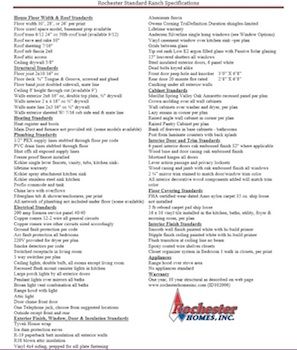 Anyone who has considered building a new home will tell you there are a lot of available choices. Indeed, those who have actually gone through a new home construction project will talk about the importance of understanding what your builder is providing. There is so much to choose from; manufactured homes, mobile homes, trailers, single-wides, double-wides, modular homes, systems built homes, boca code homes, site-built homes, stick-built homes, custom homes, track built homes, pre-fabricated homes, and so on. Regardless of the name of the construction method, the most important factor is: how is your home going to be built? What codes and building standards are going to be used to construct your new home?
Anyone who has considered building a new home will tell you there are a lot of available choices. Indeed, those who have actually gone through a new home construction project will talk about the importance of understanding what your builder is providing. There is so much to choose from; manufactured homes, mobile homes, trailers, single-wides, double-wides, modular homes, systems built homes, boca code homes, site-built homes, stick-built homes, custom homes, track built homes, pre-fabricated homes, and so on. Regardless of the name of the construction method, the most important factor is: how is your home going to be built? What codes and building standards are going to be used to construct your new home?
Following is a brief overview of today’s new construction codes. There are two major differences in today’s market for residential single family dwellings: HUD (Housing and Urban Development) code, or codes developed by the International Code Council (ICC). HUD code was developed by the U.S. federal government to define a set of building standards that must be used across the nation when building affordable, moveable homes. ICC codes were developed on an international level to define a proposed set of quality building standards for permanent housing. Before ICC developed a uniform code system, there were several independent codes aimed at the same thing; there are still some places that adhere to these codes, but most are moving towards adopting ICC standards. ICC codes now either encompass or refer to the appropriate code for building each part of a home, such as; National Electric Code (NEC), International Energy Conservation Code (IECC), and International Residential Code (IRC) for examples.
This is where the codes become intricate. Unlike the HUD code, which is enforced nationally, each U.S. state (or county) has the choice to adopt certain portions, or none, of the ICC codes. Permanent housing building standards need to be able to vary depending on building location so that materials and labor are neither wasted or under-utilized, depending on the area. For instance, the local codes in your building area may not need to reflect some of the same energy conservation code requirements that would be beneficial to a home in a different climate.
The underlying point in all this comes back to the fact that this is a major investment on many levels. Only through an educated discussion with a trusted builder who has a quality reputation, can you feel confident in what you are buying. Are you buying a manufactured home, which will stay on a metal frame and is built to national codes? Or, are you looking for a permanent residence that is built to whatever version of code your local building authority has adopted? Whichever you are looking for, be sure you understand the codes and regulations your builder uses. The method in which two different types of homes are financed, insured, and appraised are very different.
At Rochester Homes, we build homes that are built to your local code level or above and fall under ICC codes, which are the same codes a site built home should be using. We use purchasing power and systems building technology to give you the quality home you want, while offering you the ability to customize, all in a timely manner. Because we build our homes indoors, we can protect your home from being exposed to bad weather during the construction process. And finally, because of our systems building methods, we can save you money compared to traditional building methods, while providing you the home of your dreams.
